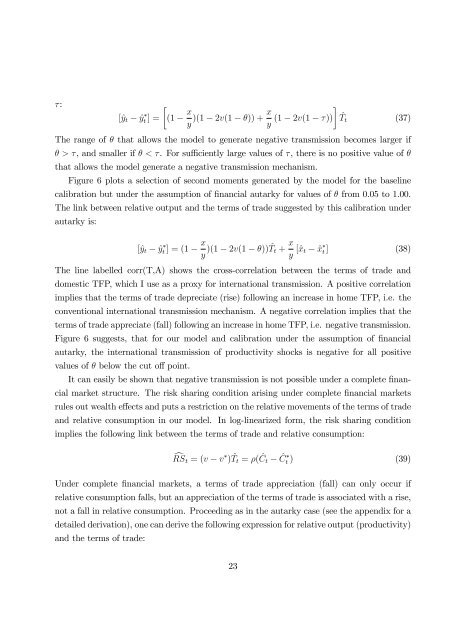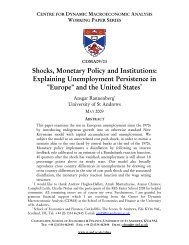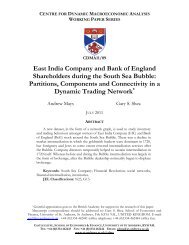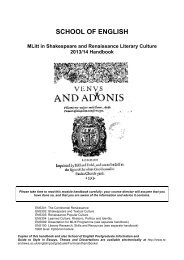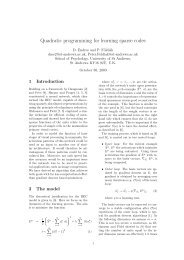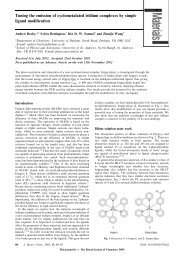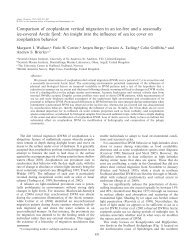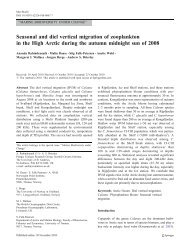Exchange rate dynamics, asset market structure and the role of the ...
Exchange rate dynamics, asset market structure and the role of the ...
Exchange rate dynamics, asset market structure and the role of the ...
Create successful ePaper yourself
Turn your PDF publications into a flip-book with our unique Google optimized e-Paper software.
:<br />
[^y t ^y t ] =<br />
<br />
(1<br />
x<br />
y )(1 2v(1 )) + x <br />
y (1 2v(1 )) ^T t (37)<br />
The range <strong>of</strong> that allows <strong>the</strong> model to gene<strong>rate</strong> negative transmission becomes larger if<br />
> , <strong>and</strong> smaller if < . For su¢ ciently large values <strong>of</strong> , <strong>the</strong>re is no positive value <strong>of</strong> <br />
that allows <strong>the</strong> model gene<strong>rate</strong> a negative transmission mechanism.<br />
Figure 6 plots a selection <strong>of</strong> second moments gene<strong>rate</strong>d by <strong>the</strong> model for <strong>the</strong> baseline<br />
calibration but under <strong>the</strong> assumption <strong>of</strong> …nancial autarky for values <strong>of</strong> from 0.05 to 1.00.<br />
The link between relative output <strong>and</strong> <strong>the</strong> terms <strong>of</strong> trade suggested by this calibration under<br />
autarky is:<br />
[^y t ^y t ] = (1<br />
x<br />
y )(1 2v(1 )) ^T t + x y [^x t ^x t ] (38)<br />
The line labelled corr(T,A) shows <strong>the</strong> cross-correlation between <strong>the</strong> terms <strong>of</strong> trade <strong>and</strong><br />
domestic TFP, which I use as a proxy for international transmission. A positive correlation<br />
implies that <strong>the</strong> terms <strong>of</strong> trade depreciate (rise) following an increase in home TFP, i.e. <strong>the</strong><br />
conventional international transmission mechanism. A negative correlation implies that <strong>the</strong><br />
terms <strong>of</strong> trade appreciate (fall) following an increase in home TFP, i.e. negative transmission.<br />
Figure 6 suggests, that for our model <strong>and</strong> calibration under <strong>the</strong> assumption <strong>of</strong> …nancial<br />
autarky, <strong>the</strong> international transmission <strong>of</strong> productivity shocks is negative for all positive<br />
values <strong>of</strong> below <strong>the</strong> cut o¤ point.<br />
It can easily be shown that negative transmission is not possible under a complete …nancial<br />
<strong>market</strong> <strong>structure</strong>. The risk sharing condition arising under complete …nancial <strong>market</strong>s<br />
rules out wealth e¤ects <strong>and</strong> puts a restriction on <strong>the</strong> relative movements <strong>of</strong> <strong>the</strong> terms <strong>of</strong> trade<br />
<strong>and</strong> relative consumption in our model. In log-linearized form, <strong>the</strong> risk sharing condition<br />
implies <strong>the</strong> following link between <strong>the</strong> terms <strong>of</strong> trade <strong>and</strong> relative consumption:<br />
cRS t = (v v ) ^T t = ( ^C t<br />
^C t ) (39)<br />
Under complete …nancial <strong>market</strong>s, a terms <strong>of</strong> trade appreciation (fall) can only occur if<br />
relative consumption falls, but an appreciation <strong>of</strong> <strong>the</strong> terms <strong>of</strong> trade is associated with a rise,<br />
not a fall in relative consumption. Proceeding as in <strong>the</strong> autarky case (see <strong>the</strong> appendix for a<br />
detailed derivation), one can derive <strong>the</strong> following expression for relative output (productivity)<br />
<strong>and</strong> <strong>the</strong> terms <strong>of</strong> trade:<br />
23


